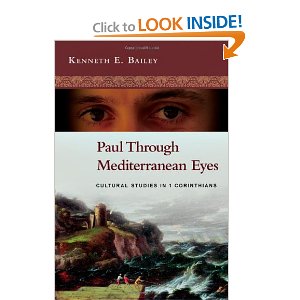One of the more interesting bits of discussion comes in addressing the issue of the Collection for the Jerusalem Church mentioned in 1 Cor. 16 (pp. 484-85). Bailey is of the opinion that when Paul refers to letters of commendation he is talking about letters the Corinthians must write to commend their own members who will carry the collection to Jerusalem, accompanied by Paul. That is, it is not Paul writing the letter of commendation but the Corinthians themselves. This is probably right. They would have known their members and their trustworthiness better than Paul. Bailey suggests the story of an incident during the reign of Tiberius 20 years previous might be relevant, where a Jew who presented himself in Rome as a teacher of the Law convinced a woman convert named Fulvia to give him purple and gold for the Temple in Jerusalem. She did so, and he kept it. When her husband discovered this, he petitioned Tiberius and Jews were suddenly banished from Rome. This is an interesting incident, but it probably bears no relevance to the discussion in 1 Cor. 16 because: 1) Paul is in a very different city where the Emperor is not; 2) Paul may or may not be referring to Jewish Christians from Corinth doing the delivery; 3) it’s a couple of decades and two Emperor’s later; 4) this is an in house matter. Funds are not being solicited in a public way for a public or even personal venture or trip. We are talking about a Christian group going to Jerusalem.
Bailey is also of the opinion that there were Zealots lurking in Jerusalem that would have been interested in getting their hands on the money, or at least reporting the heretics to someone. We do not know that there was a Zealot movement or presence in Jerusalem in the early 50s A.D. Bailey however is certainly correct that Paul wants the Corinthians to cast their eyes beyond their immediate circle and become a missional church. He also wants them to provide him with traveling money when he goes from Corinth to somewhere else on his next trip that involves Corinth. Paul is not shy about asking for money for himself or for other worthy causes.
For some odd reason (see pp. 488-89), Bailey seems to think that Gallio was a judge with a one year appointment to Corinth. This is incorrect. He was the governor/proconsul of the province of Achaia, and he certainly did not have a one year appointment. There may however be some merit in the idea that Paul left when he saw that Gallio was leaving, since the next governor might not be so helpful to Paul.
Pp. 492-93 are something of a cautionary reminder that how you view the composition of a document like 1 Corinthians, in part determines how you interpret it. Bailey imagines rings within rings, an elaborate careful composition, perhaps multiple drafts, perhaps pre-set pieces like 1 Corinthians, and then finally handing it over to a Sosthenes to compose a final draft in a fair hand. He rejects the notion that Paul’s mentioning his handwriting at the end means that here alone he composes a bit at the end of the document, having relied on the scribe up to this point. But this is exactly what a reference like that suggests here, and at the end of Romans and 2 Thessalonians and Galatians. Paul has composed this document by dictation, just as Cicero did with Tiro, and has signed it to authenticate the whole, at the end. Which explains why there are infelicities of grammar, syntax, structure, anacoluthon, etc. along the way. The poor scribe could not entirely always keep up… hence some incomplete sentences. And no, we do not have all these elaborate carefully composed ring structures in 1 Corinthians.
At the end of the book Bailey discusses marana tha, and opts for the translation ‘the Lord has come’ chiefly on the basis of the Syriac rendering of the text. He is right it deserves close consideration. It is a help to have someone like Bailey to canvas the Syriac, Aramaic, Coptic, Arabic versions. Their renderings must be taken seriously and we may be thankful someone like Bailey can share such readings with the rest of us. But at the end of the day, there are very few of these readings, which, even if accepted, make any earth-shattering difference in the interpretation of 1 Corinthians, not do they really contribute a Mediterranean perspective on the ancient figure of Paul and his Gospel. They show how it was understood and applied in such settings.
In the saving the best for last category, one of the most helpful sections of this entire book is the first appendix (pp. 500-08). Here Bailey compares Amos to 1 Corinthians in terms of themes and some phrases and some imagery and metaphors (e.g. idolatry, immorality, the day of the Lord, divisions). There are indeed a good number of parallels and one could even go further and say that Paul saw his prophetic calling as like the calling of Amos who went to a people that was not his own. Bailey also notes the role that Amos 9.11-12 as part of the decision of the Jerusalem Council about what to do in regard to Gentiles. If indeed Paul is implementing the Decree in 1 Corinthians, and I think he is, this connection is important and could explain some of the echoes of Amos in 1 Corinthians.













